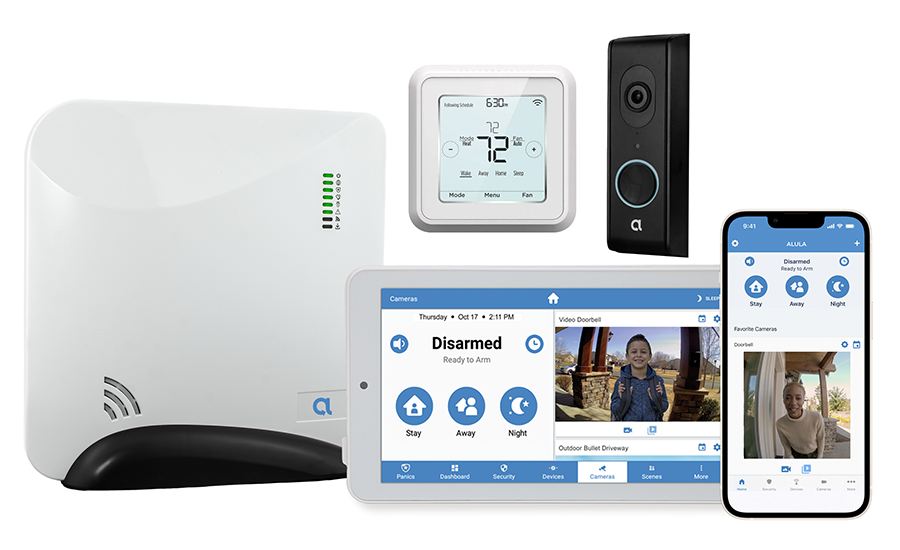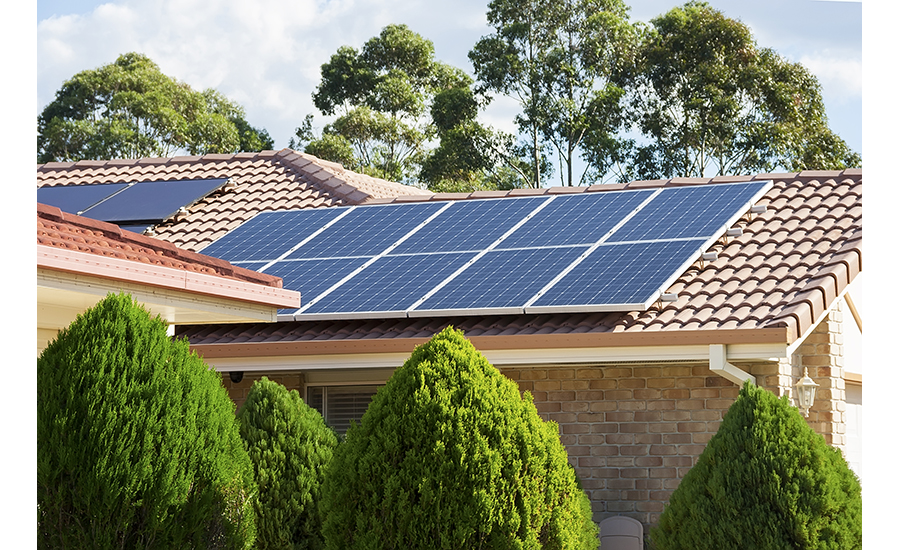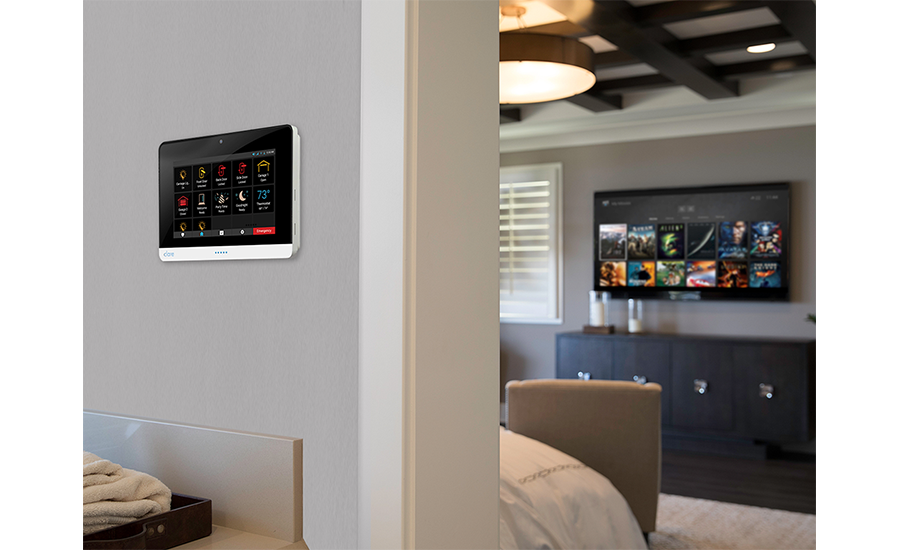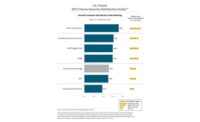The growth of smart home devices is on the rise and shows no signs of slowing as consumers continue to view security as part of their overall smart home ecosystem. A variety of trends suggests that 2023 will be an “extremely opportunistic window” for security and smart home professionals, our sources say.
Increasingly, smart home systems are becoming part of an overall ecosystem that rolls up both convenience and security, says Scott Harkins, vice president of sales at Resideo, Scottsdale, Ariz. “Smart products continue to grow in the market,” he says. “Data suggest that when the consumers make the decision, they overwhelming choose smart home technology. A large percentage of ‘burglar’ alarms are now smart home solutions and offer the opportunity to improve the integrator’s RMR by adding thermostats, lights, locks and more. The key is to allow the consumer to participate in the decision process; they will see the value.”
Over the last two years, and spurred by COVID-19 quarantines and work-from-home options, consumers have become more accustomed to connected property technology and expect these systems to provide not only security, but also convenience, operational efficiencies and business insights, says Stephanie Kinney, director of product management at Alarm.com, McLean, Va. “Security dealers have evolved into technology providers, and this is creating real growth in the industry,” she says.
Although connected smart products are not standard in the home just yet, they are quickly becoming a consumer expectation, Harkins says. “We have already passed an important mile marker on the smart home journey: that is, some large builders have come to offer smart products as standard in the home,” he says. “While there may be risk of an economic downturn slowing that transition, it has clearly begun, and I believe it will continue to gain momentum.”
According to Statista, there will be an estimated 481.9 million smart homes across the world by 2025, with revenue related to smart home expected to show a 13.64 percent annual growth rate through 2027 and household penetration reaching 28.8 percent by 2027.
Hippo Insurance, which surveyed all demographics of smart tech users across the country, finds that convenience is the most significant factor for consumers to add smart home devices (46 percent), with fire-theft alarm systems ranking as the top protective device by 37 percent. The Hippo survey also found that 36 percent of men and women ages 35 to 54 think that cameras provide the most protection for their homes, while 14 percent of women ages 25 to 34 ranked automatic locks as the most protective smart home device.

More smart home services are being added as consumers demand a hybrid of security and convenience. Alula’s Connect+ Security System provides security dealers with a wireless system designed for easy installation and a wide range of residential and small business applications. // IMAGE COURTESY OF ALULA
A Steadily Increasing Demand
Customer demand for more — and more sophisticated — smart home devices has continued along a steady pace of increased adoption, with increased expectations from more educated consumers, says Clint Choate, senior director, security market at Snap One, Charlotte, N.C. Demand accelerated during the COVID-19 pandemic as more consumers turned their attention to their “at-home” lifestyles, and the trend continues today. Big tech engagement and DIY products are also driving consumer interest, he adds. “Smart home devices are not an exception anymore, they are the norm,” he says. “It’s not a ‘last year thing,’ as this has been happening for several years and continues to drive adoption.”
Consumers who had a smart home system installed during the pandemic have now been living with that system for some time, meaning they may be ripe for system additions, or modifications, says Mitchell Klein, executive director, Z-Wave Alliance and director, alliances strategy, Silicon Labs Smart Home Market. “Beyond that initial boom to business [during COVID-19], 2023 represents an opportunistic window for security integrators to follow up with customers to learn more about what they love about their systems and what they wish they could change,” he says. “So the integrator can be the solution to those problems, either through upgraded equipment or minor changes to programming.”
Today’s consumers are demanding smart home enhancements that parallel what’s happening on the commercial side of security, says Kinney of Alarm.com. “We continue to see demand for residential video solutions, including doorbell cameras, outdoor cameras with professional monitoring [video verification] and indoor cameras. We are also seeing a shift of customers wanting proactive solutions, not reactive solutions, as cameras and technology become smarter.”
This presents dealers and integrators with a unique opportunity to serve their customers as both smart home and security experts. “Integration firms that keep their ear to the ground to stay up to date on latest advancements will be well positioned to not only handle inquiries that come their way, but secure new business as well,” Kinney adds.
Ongoing Evolution of New Products
While fire and security detection systems, video security cameras and doorbell cameras are probably the most commonly deployed smart home devices, new smart home products are coming on the market all the time. These include garage door controllers, smart lighting, water sensors, air quality sensors, energy usage monitoring systems and more.
For example, Resideo predicts growth in the water leak detection and shutoff valves market in the coming year. Such systems enable security professionals to work hand in hand with insurance companies to minimize underwriting risk and reduce cost, Harkins says. And the company plans to deliver new services to the market that allow “non-traditional” connected products to become another monitored point within the home, he adds.
Last June, Alarm.com introduced its new solar monitoring integration system, which enables homeowners with SolarEdge or Enphase inverters to monitor their home solar panel energy production and consumption through a mobile app, empowering them to make smarter decisions about home energy use, Kinney says. “When Alarm.com launched the solar program for service providers in June 2022, we saw immediate interest in the opportunity to build new growth opportunities and deliver an enhanced end user experience,” he said. Today, more than a thousand Alarm.com providers have completed its solar certification training, and the company expects solid growth of the product in 2023 and beyond.
As homeowners adopt more interconnected devices, artificial intelligence will play a bigger role in the smart home ecosystem — just as it has on the commercial security side. “AI will enter homes in video first and cross category integration down the road,” Choate says. “Giving homeowners intelligence about what is happening in and around their homes when they need to know it drives value, versus a barrage of motion events. Video will penetrate categories such as intrusion further through video integration into the burg panel (video as a zone) and integrations with central stations [video verification].”
Warren Hill, vice president, marketing and partner development at Alula, St. Paul, Minn., agrees on the growing importance of AI to smart home ecosystems. “Camera offerings with enhanced AI will continue to further the role that video plays as a component of the complete security ecosystem,” he says. “Video is a hot and sought-after piece among security consumers. Several video solutions already exist throughout the market. Some are stand-alone solutions while others are part of an integrated security ecosystem.”
Along with AI, data analytics will also play a growing role in the future of smart homes. “Rapid improvement in data analytics will enable new business cases and new services for the security dealer,” Harkins of Resideo says. “[It's] not just data from a security system, but data that generates a high-definition view of one’s surroundings based on several data inputs like cameras, Wi-Fi signals, cell phones, presence detection and alarm signals. This introduces the opportunity to have a real impact on false alarms and more rapidly respond to serious issues within the home.”

New smart home applications go well beyond the traditional doorbell cameras and video security. Alarm.com recently introduced an integrated solar monitoring system, which enables homeowners to monitor their home solar panel energy production and consumption through a mobile app. // IMAGE COURTESY OF ALARM.COM
Gearing Up for Growth
Security professionals are gearing up for increased demand for smart home products as part of an overall home security system. “We are building products with improved smart capabilities and our services are increasing the ease of utilizing smart technologies through schedules and easy-to-operate triggers,” Hill of Alula says. “We manufacture devices that talk to other devices and create a hands-free automation experience, providing our customers with a comprehensive solution.”
Harkins adds that Resideo’s strong presence in both the home security and home HVAC segments puts the company in a good position to accommodate future growth of the smart home market. “These two segments are foundational to what makes a smart home ‘smart,’” he says.
“Our solutions — like thermostats, cameras, security systems, water shut-off valves, air quality — are the key pieces of the smart home. Our channel to market, the professional security dealer, continues to be well positioned to ride the smart home macro trends.”
Snap One is steadily increasing market share through its mid-market smart home security and surveillance lines, ClareVision and ClareOne, and its smart home platforms through its Control4 brand offerings. “For mid-market, we offer a unique recurring monthly service fee model for our ClareOne smart home security system and strictly stick to local storage for the ClareVision video line,” Choate says. “Consumers are increasingly wary of offsite storage from both a privacy and a cost perspective.”
Because smart home system operational efficiency will be more important than ever, Alarm.com has invested heavily in end-to-end solutions and technology that helps partners acquire, develop and engage customers as efficiently as possible, Kinney says. “We are seeing more engagement with our Alarm.com partner tools and services that help service providers streamline operations at a time when many are facing higher labor costs and reduce workforce capacity,” she adds. “For example, partner tools can help on-site technicians install systems faster and more reliably, and enable remote customer support to efficiently address issues and provide a great customer experience.”
Not Without Challenges
However, strong market growth in the smart home market doesn’t mean that future sales are a slam-dunk for integrators, sources caution. Rising costs and product availability continue to present challenges for suppliers, a problem that’s likely to trickle down to the consumer level, Hill says. Additionally, the shadow of a future recession hangs heavy on the general economy, causing consumers to be more selective on how they spend their discretionary income. “Integrators need to select partners that allow them to scale their offering so you can choose the products and services that consumers most need and can afford,” he notes.
The economy and specifically new home construction may be a challenge to market growth in 2023, Choate of Snap One predicts. “Renovations in general may decrease as costs increase,” he says. “Home resale will take a hit because fewer people want a new mortgage [new resales trigger retro work] and renovation of homes for personal reasons may take a hit for the same reason.”

Ease of use is critical for smart home systems. Pictured is Snap One’s ClareOne smart home security system, which is specifically targeted to mid-market consumers with a recurring monthly service fee model. // IMAGE COURTESY OF SNAP ONE
Additionally, the tight job market and the investment required to provide the necessary skills for a new hire could also put a crimp on growth, Harkins says. Resideo is addressing this issue by supporting the Building Talent Foundation’s goal of delivering 100,000 new job candidates into security markets over the next five years. “We are investing in improving the installation and trouble-shooting experience to allow new hires to gain proficiency in short order,” he says. “We are improving our software’s user experience to make installations easy and fast while also deploying technologies in our customer service organization that allow them to be ‘present’ via video on a tech support call.”
Integrators who want to prepare themselves for the smart home boom would do well to carefully select the products they recommend, know them inside-out, and be very educated in networking a video, Choate advises. “Customers’ tolerance for problems with smart home devices is very low,” he adds. “Networking is the foundation on which almost all smart home devices are based, and video issues are very apparent when not working correctly.”
The value of the smart home creates RMR opportunities and also improves the consumer experience, Harkins says. “Redefine your view of ‘security’ beyond the traditional and expand to include high-value solutions like cameras and energy management. Explore the property technology market, specifically in the smart apartment segment where growth is expected to be robust.”
And because not all smart home consumers are created equal, integrators should segment their smart home offerings so they can provide something for everyone, says Hill of Alula. “Automation continues to be an important part of the smart home market, while broader and more in-depth integration by the masses is yet to happen. The pieces are all there, and some [integrators] are taking advantage of them, but many professional alarm dealers hesitate to go all in on automation, either because of reliability challenges they experience with the operation of the equipment or because a comprehensive automated system can be cost prohibitive to the majority of homeowners.”
This is why a “one-size-fits-all” approach doesn’t work for winning customers, Hill adds. “Make sure your portfolio, hardware and services can hit a range of price points and capabilities. For some, security with a basic hub and a phone app will suffice. For others, you’ll need multiple touch screen controls, indoor and outdoor cameras, and automated lights, locks, thermostats and more.”




